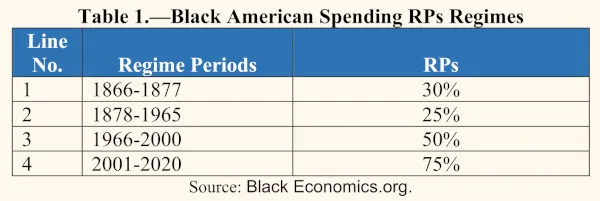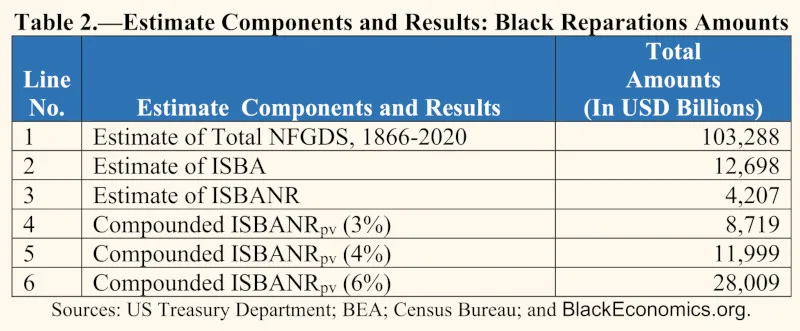 BlackEconomics.org®
BlackEconomics.org®
B. B. Robinson, Ph.D.
Introduction
This report brief presents a new estimate of a Black American Reparations amount that the US Government (USG) should consider when negotiating a Reparations agreement. The USG is singled out because it is widely agreed that no other party was, or is, more culpable in the historical and ongoing violation of Black Americans’ human and civil rights. All historical developments that have precipitated Black American Reparations have unfolded under the auspices and approval of the USG, or the USG has failed to take sufficient enforcement action to halt the violation of these rights.
Many scholars have estimated Reparations amounts for Black Americans.1 The estimates are based on a variety of concepts: e.g., an amount to close the Black-White wealth gap; the cost of unpaid or underpaid labor; the value of stolen or damaged property (land and otherwise); the current value of the 40 acres and a mule “promised” in General William T. Sherman’s US Army Special Field Order 15; estimates of selected promised, but undelivered, benefits throughout the course of US history; etc. Where relevant and historical in nature, these estimates are adjusted to account for the time value of money (i.e., compounded).
Often, the estimates offered are “indirect” with respect to the most culpable party. That is, they are not based on specific and direct USG actions. The estimate that we propose, on the other hand, represents a direct measure of Black American Reparations because it is based on USG spending actions.
The report includes four sections: (1) A conceptual overview and justification of the direct Reparations measure; (2) an estimation methodology; (3) the results of the estimation effort; and (4) a conclusion.
Conceptual Overview and Justification
The direct Black American Reparations measure reported here reflects the following perspectives:
- For simplicity, it ignores the ante bellum period. At the Civil War’s end, the USG enacted laws to elevate former enslaved persons to full citizenship and obligated itself to recognize fully formerly enslaved persons and their rights as citizens.
- As full citizens, it was and is expected that formerly enslaved Black Americans and their descendants would be treated identically to other citizens in the nation.
- From representativeness and ideal perspectives, full citizenship means that Black Americans should be the beneficiaries of USG spending in proportion, at least, to their presence in the population.
- Given that the latter did not occur and has not occurred, a “direct” estimate of Black American Reparations should be prepared in accordance with the following equation:
Equation 1:
- Because the Civil War ended in effect during the Spring of 1865, USG spending for formerly enslaved Black Americans begins in earnest during the 1866 fiscal year (FY). Consequently, the Black American Reparations amounts that are estimated here for FYs and calendar years (CYs) are for 1866-2020.
It is common knowledge that the USG failed to spend proportionately on Black Americans on an historical basis. Accordingly, underspending as determined from representativeness and ideal perspectives occurred, which justifies direct Reparations measures. Importantly, a direct measure of Reparations may be larger than those derived by indirect estimation methods.
If a Reparations amount generated from a direct measure is, in fact, larger than an amount generated by an indirect measure, then the former should be placed before the USG as a “worsecase scenario” Reparations amount. A direct measure reflects the direct action/inaction of the USG—reconfirming its role as the most culpable party and could serve as an incentive for the USG to accept a potentially lower, yet still sizeable, Reparations amount that is generated from an indirect measure.2
Estimation Methodology
The following methodology describes: (1) Estimates of net Federal Government domestic spending (NFGDS)3; (2) the use of NFGDS estimates and the percentage of Black Americans in the nation’s total population to produce estimates of USG ideal spending for Black Americans (ISBA); (3) the development of receipt regimes that characterize the proportion of ISBA actually received by Black Americans; (4) the related estimates of ISBA not received (ISBANR); and (5) the compounding of ISBANR estimates to restate past values in present value terms.
NFGDS
It is elementary that USG domestic spending is the spending of interest—not spending directed to foreign parties. Also, the focus is on operational and capital spending—not the amortization of public debt, which is likely accounted for in earlier spending. However, domestic interest payments are factored into estimates of NFGDS. It is important to keep in mind that this very broad measure is appropriate as a starting point because US citizens generally benefit directly from all USG domestic spending: In the form of compensation when they are USG employees; in the form of opportunities to serve as USG contractors when operating as entrepreneurs; and in the form of recipients of USG goods and services when operating as everyday citizens. No question about it, ideally, Black Americans should have full access to such direct benefits.4
For the years 1929-2020, NFGDS estimates were assembled from National Income and Product Accounts (NIPA) Table 3.2 (Federal Government Receipts and Expenditures) and Table 5.11 (Capital Transfers Paid and Received, by Sector and by Type). Table 3.2 provides estimates of Consumption expenditures (25); Government social benefits to persons (28); Grants-in-aid to S&L governments (31); Interest payments to persons and businesses (34); Subsidies (36); Gross government investment (45); Capital transfer payments (46) less line 15 of NIPA Table 5.11, which is Capital transfers paid to the rest of the world; Net purchases of nonproduced assets (47); and less CFC (48).5 (The numbers in parentheses are table line numbers.)
For the years 1865-1928, NFGDS estimates were obtained from two annual series of US Department of the Treasury documents available in an online archive.6 The two series are: (1) Account of the Receipts and Expenditures of the US (for years 1865-1869, 1871, 1876, 1880); and (2) Treasury Combined Statement of Receipts, Expenditures, and Balances of the United States Government (for all remaining years in the 1865-1928 period not mentioned in item 1, except for 1870). Neither series included a document for 1870; accordingly, a NFGDS value was estimated for 1870 as the midpoint between 1869 and 1871. Summary and detailed information were used from both series to derive estimates that are definitionally and conceptually as consistent as possible with those obtained from the above-mentioned NIPA Tables.
The 1929-2020 NFGDS estimates are CY estimates. The estimates obtained for 1865-1928 from the two Treasury Department series were on a July 1–June 30 FY basis. We converted the latter estimates to CYs by halving each FY estimate, assigning half to adjacent years, then combining common half-year estimates to form CY estimates. An additional adjustment was made to the 1865-1928 NFGDS estimates: A downward adjustment factor (about 20 percent) was applied consistently to account for a sizeable level difference between the 1929 NFGDS estimates derived from the Treasury Department source versus the NIPA source.
Ideal spending for Black American
Estimates of USG ideal spending for Black Americans (ISBA) were prepared by multiplying annual NFGDS estimates by the related Black American US population percentages. Annual Black American population percentages for all decades from 1860 to 2020 were prepared by adopting decadal percentages from Decennial Censuses of population and estimating percentages for intermediate years by straight-line interpolation (Equation 2).7
Equation 2:![]()
Where %Yn is for intercensal annual percentages, n assumes values from 1 to 9, %D is for decadal census percentages (in this case %D1 precedes %D2), and %D1 serves as %Yn-1 in calculating the percentage for the first intercensal year of each decade.
Therefore, Black American population percentages were used to prepare estimates of ISBAt as detailed in Equation 3.
Equation 3:![]()
Where t assumes values from 1 (1866) to 155 (2020),
Ideal spending for Black Americans not received
Estimates of ideal spending for Black Americans not received (ISBANR) were derived as the difference between estimates of ISBA and ISBA received (ISBAR). ISBAR was estimated by multiplying ISBA by a regime of judgmentally determined “received percentages” (RPs).
Judgmental RPs were developed using historical knowledge, selected statistics from the aforementioned two Treasury Department series, and other sources.8 Table 1 (next page) provides details of the judgmentally determined RPs regimes. Conversely, ideal spending for Black Americans not received (ISBANR) was estimated as ISBA multiplied by ISBA not received percentages, which are simply complements of the RPs (Equation 4).
Equation 4:![]()
Where t assumes values indicated for Equation 3.

Compounding estimates ISBANR
To finalize Black American Reparations estimates, ISBANR estimates were restated in present value (pv) terms using Equation 5:
Equation 5:![]()
Where t assumes values indicated for Equation 3, and r is the compounding rate. Note that three sets of ISBANRpv estimates were prepared using three compounding rates: 3.0 percent, 4.0 percent, and 6.0 percent.
Results
Table 2 provides the results generated by the above-described estimation methodology.

Table 2 shows that total NFGDS for CYs 1866-2020 is well over USD 103 trillion (uncompounded). The ideal amount that should have been spent over the period to benefit Black Americans based on population representativeness was nearly USD 12.7 trillion or about 12 percent of total NFGDS. Unfortunately, only about USD 8.5 trillion of USG spending was estimated to have reached and benefited Black Americans. That is, Black Americans did not receive about USD 4.2 trillion of the ideal amount. The latter figure is a direct measure of Black American Reparations on an uncompounded basis.
The table shows that, depending on the compounding rate selected, the direct measure of Black American Reparations is USD 8.7 trillion (3.0 percent), USD 12.0 trillion (4.0 percent), or USD 28.0 trillion (6.0 percent).
Conclusion
This report brief presented a methodology for estimating a direct measure of Black American Reparations. The measure is “direct” because it is derived from spending by the party (the USG) most culpable for creating the environment and for supporting actions/inactions that precipitated violations of Black Americans’ human and civil rights for which Reparations are due.
Estimates of NFGDS were obtained from USG sources. An ideal measure of spending for Black Americans based on population representativeness was estimated (ISBA). Judgmental RPs regimes were prepared along with their complements (i.e., percentages of spending not received). Also estimates of ideal USG spending for the benefit Black Americans that was not received (ISBANR) were developed. Finally, ISBANR estimates, which serve as a direct measure of Reparations, were compounded to prepare a set of Black American total Reparations estimates that range from about USD 8.7 trillion to about USD 28.0 trillion.
Interested scholars are invited to improve upon these estimates, and scrutiny of the methodology is welcomed.
The purpose of this report brief was to shine a bright light on the USG’s failure to extend due financial resources to Black Americans, who exited slavery without the wherewithal to support themselves. The estimates reveal that even a liberal recognition of USG spending to bolster a weak (Black American) segment of its population following the Civil War was insufficient when assessed on a representativeness basis. Consequently, the USG should find these estimates to be a relevant and sound response to the question: “What is a justifiable Black American Reparations amount?”
The USG could find that a direct measure of Reparations to be beyond its capacity to pay. Consequently, the USG should consider with deep interest an indirect measure of Black American Reparations that may be lower in value and potentially acceptable by Black Americans as a Reparations amount.
Once agreement is reached on a Black American Reparations amount, then negotiations can begin concerning the forms that Reparations should take.
### — ###
1 For examples of suchestimates, consider Chapter 13 of William Darity and Kirsten Mullens (2020), From Here to Equality: Reparations for Black Americans in the 21st Century, University of North Carolina Press, Chapel Hill. Notably, this report brief does not include a discussion of the forms that Reparations should take. However, the expectation is that a full Reparations amount will be determined, and then decisions will be made concerning the forms that Reparations will take, the value of which will sum to the full Reparations amount.
2 On the other hand, Black Americans may lock in on the direct Reparations measure given its conceptual and methodological foundations. Keep in mind that the direct measure does not address the ante-bellum period.
3 “Net” is used here because estimates of Consumption of fixed capital (CFC, an imputed depreciation-like measure) do not represent actual spending. Estimates of CFC, which are reflected in Federal Government Consumption Expenditures, are removed from National Income and Product Account estimates obtained from the US Department of Commerce, Bureau of Economic Analysis (1929-2020). Estimates obtained from the US Treasury Department do not include CFC estimates (1865-1928).
4 Of course, US citizens benefit broadly from USG spending indirectly when outcomes that result from that spending are favorable for citizen.
5 NIPA Tables 3.2 and 5.11 are from the US Department of Commerce, Bureau of Economic Analysis: www.bea.gov. (Ret. 111123)
6 The archive is located at https://www.govinfo.gov/app/search/%7B%22query%22%3A%22governmentauthor%3A(Treasury%20Department)%20AND%20branch%3A(executive)%22%2C%22offset%22%3A0%2C%22sortBy%22%3A2%7D (Ret. 11/14-23/2023).
7 Decadal Black American population percentages were assembled for Wikipedia from US Census Bureau statistics: https://en.wikipedia.org/wiki/Historical_racial_and_ethnic_demographics_of_the_United_States#Black_population_as_a_percentage_of_the_total_population_by_U.S._region_and_state_(1790%E2%80%932020). (Ret. 111523)
8 Evidence of the USG’s failures to direct spending to Black Americans proportionately is widespread. As one example, consider that, in 1867, most USG spending specifically intended for Black Americans was directed through the Freedmen’s Bureau, which operated under the War Department. Page 459 of the Account of the Receipts and Expenditures of the US for 1867 reveals that almost $7 million was available for spending by the Freedmen’s Bureau, but only about $2.2 million was paid out (relatedly, see Ira Colby (1985), “The Freedmen’s Bureau: From Social Welfare to Segregation,” Phylon-(1960): https://doi.org/10.2307/274830). Moreover, it is common knowledge that the USG served as an early and large employer of Black American labor. In fact, during the Civil War, the USG employed nearly 200,000 Black American soldiers disproportionately in low-level positions. Notably, Black Civil War soldiers’ effective compensation was about 55 percent of that of White soldiers. (See “Black Soldiers in the U.S. Military During the Civil War, National Archives; https://www.archives.gov/education/lessons/blacks-civil-war#:~:text=Black%20soldiers%20were%20initially%20paid,no%20clothing%20allowance%20was%20drawn.) This racial bias in compensation continues today. More recent evidence on this matter is found in Bernard Anderson (1965), “Employment of Negroes in the Federal Government,” Monthly Labor Review: Vol. 48, No. 10; pp. 1222-27. Using statistics from Anderson’s article it was estimated that the compensation amount for Black USG employees was, on average, about 70 percent or less than that received by White USG employees in the early 1960s. For selected examples of the USG’s failures to deliver an ideal level of spending and related benefits to Black Americans as part of the former’s ongoing efforts to meet human requirements, see: (1) Ta-Nehisi Coates (2014), “The Case for Reparations,” Atlantic Magazine: https://www.theatlantic.com/magazine/archive/2014/06/the-case-for-reparations/361631/; William Darity and Kirsten Mullens (op cit. footnote 1); and Chapters 5-12 of California Task Force to Study and Develop Reparations Proposals for African Americans, Final Report: https://oag.ca.gov/system/files/media/full-ca-reparations.pdf. (URLs cited in sources cited in this footnote were retrieved on 11/11-19/23.) It is important to note that, even when the USG directs spending toward Black Americans, White American personnel and private sector contractors often benefit more from the spending than do Black Americans.


